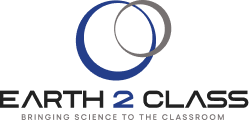Originally presented 29 Sep 2007
The Earth2Class Workshops this Fall feature two special themes: the “IODP (Integrated Ocean Drilling Program) ‘School of Rock’ Workshops” and the “Lamont Contributions to the IPY (International Polar Year).”
In July, seventeen teachers and twelve IODP researchers and staff members participated in the “School of Rock 2007: Exploring Ocean Cores at the Gulf Coast Repository.” In our September and October E2C workshops, LDEO Borehole Research Group scientists Jill Weinberger, Gilles Guerin join E2C Organizer Dr. Michael J. Passow, and others to share some of the data and concepts presented at this program, along with selected educational activities and materials developed by the first and second SOR participants.
Jill came to LDEO in 2006 as a Post-Doctoral Research Scientist, after earning her Ph.D. at Scripps Institution of Oceanography. She is particularly interested in the interaction of geologic structure, sediment properties, and fluid flow in the formation of gas hydrate deposits. Much of her research is based on participation in Ocean Drilling Program Leg 204. Jill has now returned to California to continue her research.
Click on the icons above to see additional resources.
Introduction to this Workshop
View the introductory slide show (web page) or introductory PowerPoint.
Related E2C Workshops about Ocean Drilling and the JOIDES Resolution by Geraldo Iturrino can be viewed at:
- “Probing Beneath the Surface–Hydrothermal Systems”—Gerardo Iturrino (Dec 2001)
- “Borehole Research and the Ocean Drilling Project”—Gerardo Iturrino (Sep 2002)
- “Structure and Composition of Earth’s Crust” — Gerardo Iturrino (Jan 2004)
- “IODP: The Integrated Ocean Drilling Project” — Gerardo Iturrino (Sep 2004)
- “Integrated Ocean Drilling Program’s Latest Discoveries” with Gerardo Iturrino (May 2006)
- Here’s the direct link to the JOI Learning “School of Rock 2007.”
- Click here if you want to know more about “School of Rock 2005.”
Cutting-Edge Research
Here is a link to the presentation by Dr. Jill Weinberger. You can also access this and related presentations through the BRG Educational Resources web site.
Visit Dr. Jill Weinberger’s home page to learn more about her background and research.
Below are two key sections that relate to this Workshop:
My research focuses on the interaction between subsurface fluid migration, lithology, and tectonics. This interaction affects a wide range of geologic processes from the mechanical properties of faults to the distribution of mineral resources and is of immediate societal interest for its influence on hazardous waste remediation, water resources management, and slope stability issues. In the marine environment, the influence of fluid/sediment interactions on methane gas hydrate distribution has been a topic of recent interest because this compound, an ice-like crystalline solid in which a lattice cage of water molecules traps a molecule of methane gas,
has been touted as an agent for climate change, is a potential new source of economically recoverable organic carbon, and likely influences sub-marine slope stability.“
Hydrate Ridge
Hydrate Ridge, OR is an accretionary ridge located ~100 km offshore central Oregon. It is formed by the subduction of the Juan de Fuca Plate beneath the North American Plate. Scientific interest in Hydrate Ridge has made it the focus of several international, interdisciplinary, studies in recent years. I participated in Ocean Drilling Program (ODP) Leg 204, to southern Hydrate Ridge as a sedimentologist/structural geologist in order to determine the role of subsurface fluids in controlling the distribution of hydrate in this complex geologic environment.
Classroom Resources
JOI Learning — Home page for the Joint Oceanographic Institutions education program
Here are some direct links from JOI Learning:
Elementary and Secondary activities
Other Resources for This Topic
Ocean Drilling Program Leg 204 Initial Reports
Integrated Ocean Drilling Program (IODP)
Greatest Hits Volume 1: 1985-1996(PDF; 1.8 Mb)
Greatest Hits Volume 2: 1997-2003 (PDF; 2.2 Mb)


